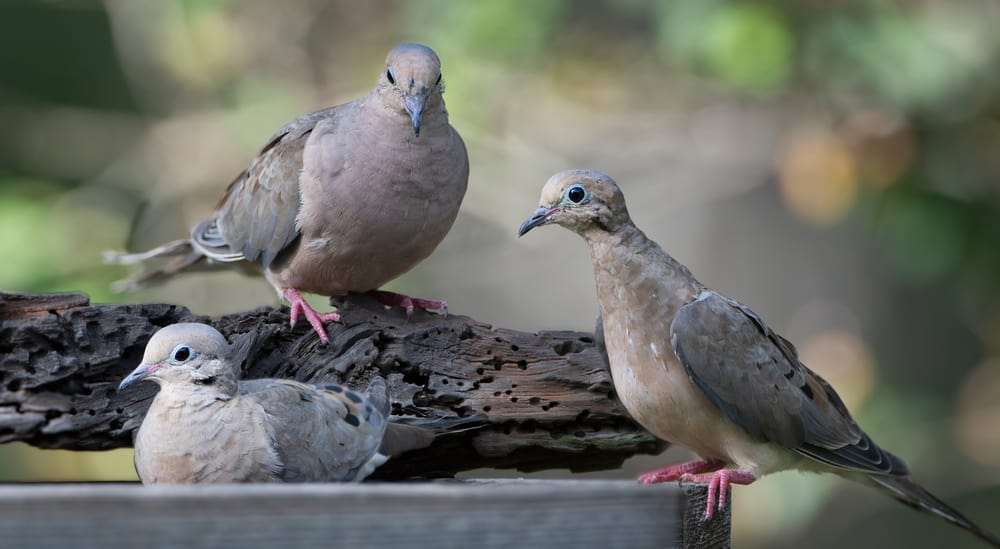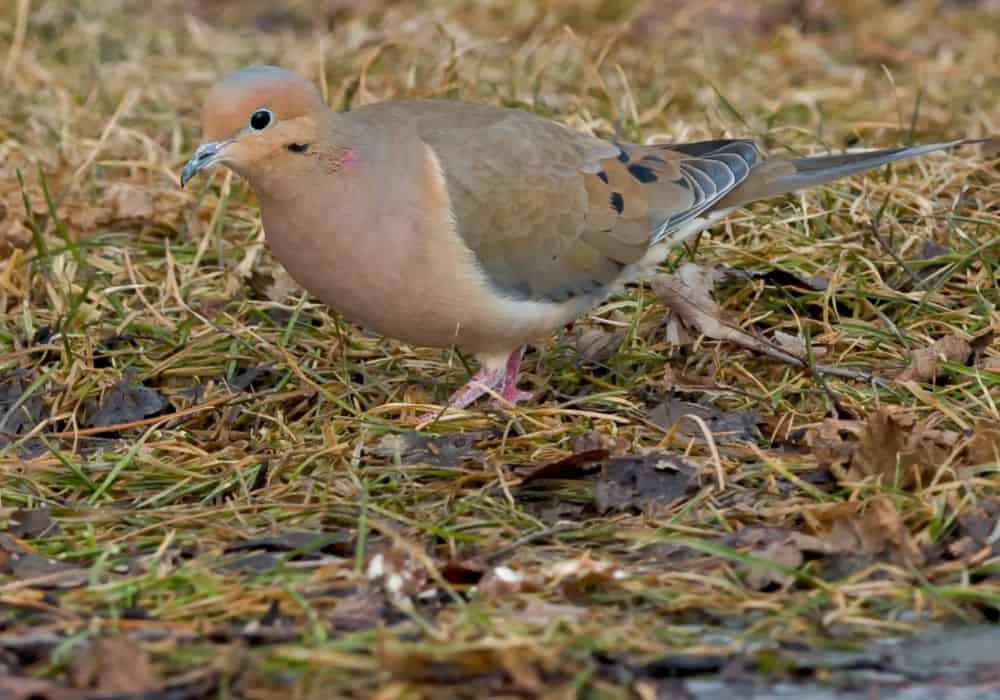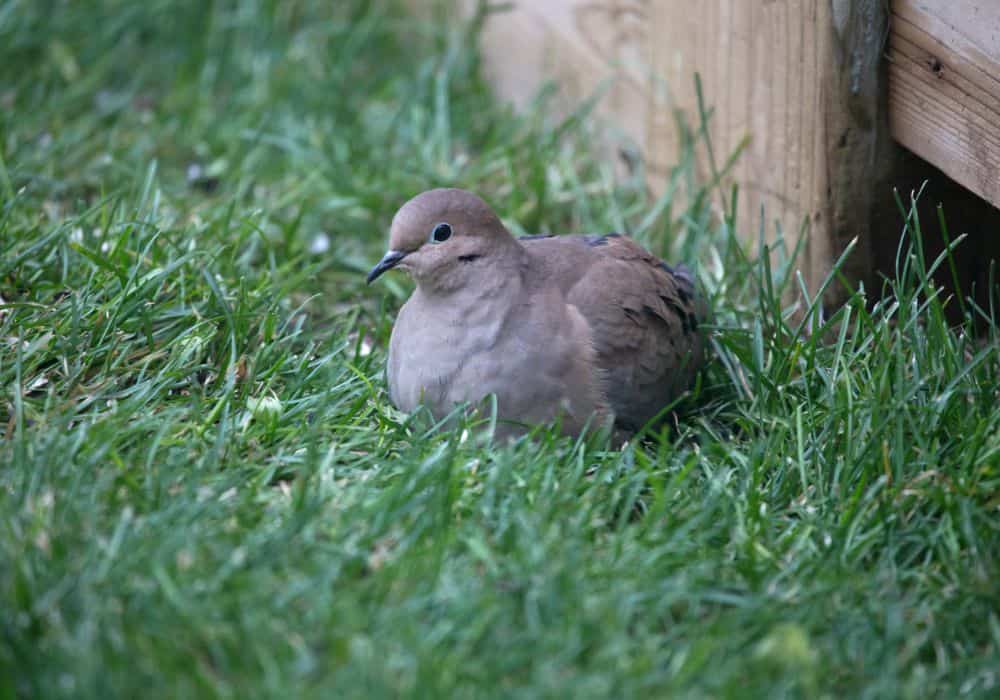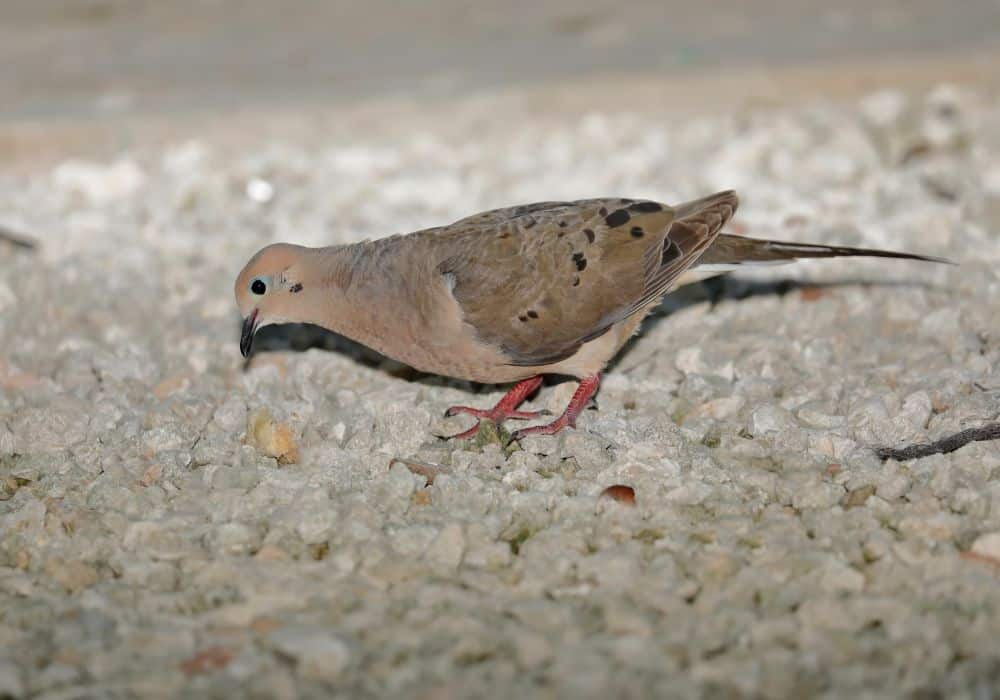Have you ever walked out of your house in the spring to hear the soft, whistle-like cooing of a bird in your area? If this cooing was sad, loud, and persistent, you might’ve been listening to a mourning dove try to mate with its wooing call!
Let’s learn more about these fascinating creatures and what you can do to befriend and assist these fascinating birds. To do this, we must ask ourselves one simple question: what do mourning doves eat?
Facts About Mourning Doves
According to an article by the National Parks Board of Singapore, mourning doves fall under the Columbidae family, much like other pigeons and doves.
Columbidae birds are known for their thick, round bodies, short necks, and thin peaks. Mourning doves generally are about 12 inches in length, have a wingspan of 37 to 45 centimeters long, and have feet with three toes facing forward and one toe facing backward.
The large black dots can easily recognize an adult mourning dove on its wings. This bird’s back and upper sides are gray, and its underbelly is peach-colored. It also has a thin, black beak and pink legs, according to AllAboutBirds.org.
The habitat of these birds tends to be in temperate climates, such as forest clearings, deserts, suburbs, prairies, and farmlands. Due to this, mourning doves can be found in most of North America, southern Canada, and central Mexico.
How Do Mourning Doves Reproduce?
During mating season, from March to September, male mourning doves will court female doves through a mating ritual involving flying loudly in long circular glides. Male mourning doves also tend to puff out their chests and bow to female doves while on the ground.
It is the role of the male mourning dove to seek out potential nesting sites for their partner, but it is the female dove that ultimately chooses the site for the pair to live in.
These sites tend to be 40 to 100 feet from the ground in trees, shrubs, or building ledges. Mourning dove nests are made of twigs, provided by the male doves and used by the female doves to construct said nests.
To continue, mourning dove eggs are white. The incubation process, performed by both parents, lasts about 14 days. At 15 days old, baby mourning doves will leave the nest, though they will usually stick around for a couple of weeks as they learn to take care of themselves.
Lastly, a mourning dove can live to be two years old in the wild, and a pair can have as many as 5 to 6 baby birds, or broods, a year. Mourning doves also mate for life.
What Do Mourning Doves Eat?
Mourning doves are granivorous. As such, they primarily eat undergrowth, grains, seeds from wild grasses, herbs, and sometimes berries, as stated by Lyric Bird Food. To add to this point, another website, Birdfact.com, specifically described the mourning dove as a vegetarian forager.
This article lists the following grasses as favorites of the beautiful bird: foxtail, panic grasses, Colorado grass, pigweeds, and plains bristlegrass.
In the wild, mourning doves might also eat the occasional snail, if necessary, though they tend to prefer seeds, grains, and grasses as their primary food source.
What Human Foods Can Mourning Doves Eat?
The few human foods mourning doves can eat include grains and seeds humans typically eat as snacks, commonly found in almost any kitchen. These foods include peanuts, corn, sunflower seeds, wheat, and rye.
These grains and seeds are relatively easy for the small mourning dove to access in the wild. In other words, mourning doves don’t have to dig into the ground to eat these common goods, making foraging for these foods that much easier.
What Do Mourning Doves Eat in the Garden?
Birds and Blooms report that mourning doves can be helpful to gardeners and farmers alike. While mourning doves do not eat insects, they are granivores, meaning that they do eat weeds and weed seeds.
Mourning doves, as previously mentioned, tend to forage the ground in search of seeds to eat. As such, if your garden or lawn has plants with roots prone to scattering on the floor instead of another reproductive method, a mourning dove might visit your home to eat.
What Are the Predators of Mourning Doves?
The mourning dove has a high mortality rate. This is due to the species being a valuable game species. In other words, the US government made these birds a legitimate hunting quarry.
This high mortality rate, however, does not significantly impact the species, as about 15% of mourning doves are hunted without it seriously affecting their population.
The mourning dove’s primary predators include hawks, falcons, owls, snakes, and raccoons. Feral and domesticated dogs and cats also hunt these tiny birds.
The loud take-off of the mourning dove allows many predators to hunt it easily. As such, mourning doves have developed a few defensive mechanisms to survive in the wild.
How Do Mourning Doves Protect Themselves?
One method mourning doves frequently use to protect themselves from predators is to fly in groups. Wicked Local states that these birds will travel in flocks to increase their collective vigilance.
In other words, when traveling together in groups, mourning doves will keep each other safe by watching for predators, such as the mentioned falcons or cats.
If they spot a dangerous animal nearby, these birds have learned to communicate such dangers to their community by moving a feather in a particular motion during take-off to create a specific noise they’d make as they fly away.
This also has the added benefit of hiding any injured or slow doves within the group, thus confusing any owls, raccoons, or predators in general.
How to Attract Mourning Doves?
Mourning doves are beautiful creatures, and there are a few ways for you to attract them to your home. The primary way to do this would be to improve and maintain the environment in your neighborhood.
For example, The Spruce, a company dedicated to practical and inspirational home-keeping advice, explains that you can provide these birds with their favorite foods, fresh water, and even well-kept trees to grab their attention.
You can place bird baths on your lawn or position sprinklers to create puddles as somewhat natural bird baths for these birds to visit and use.
Finally, you can also clean up and prune the trees near your home to ensure that the doves feel comfortable visiting and can use them to create their nests.
If you would like, you can also provide some valuable nesting materials for these birds when they visit. Such materials include small sticks, twigs, pine needles, and grasses. Creating simple platforms or shelves for mourning birds to settle into can also help tremendously.
Can You Make Wild Doves Pets?
It is important to note that while you can lure mourning doves to your home, you cannot keep these birds as pets. This is the case, at least in North America.
This is due to the Migratory Bird Treaty Act of 1918. Under this act, mourning doves are considered a protected species, meaning they cannot be killed, captured, sold, traded, or transported without authorization by the Department of Interior US Fish and Wildlife Service.
How to Feed Mourning Doves?
To feed Mourning doves, you can set up bird feeders around your home with grains and seeds. The best feeders for mourning doves are those with wide-open platforms or tray feeders. You can fill these feeders with sunflower seeds, milo, corn, wheat, and millet.
What Should You Not Feed Doves?
While there are great food options for your bird feeders, there are foods that mourning doves are either simply not interested in or will not benefit from.
Black-striped sunflower seeds, peanuts still within their shells, flax seeds, and canary seeds aren’t appealing to mourning doves. Regarding nutritional value, iceberg lettuce and bread provide very little and are not recommended for these birds either
Lastly, mourning doves do not like fruit and nectar feeders, which is understandable given that they are granivores and prefer grains and seeds.
Final Words
To conclude, mourning birds are gentle birds that forage for food by digging up seeds and grains they find on the ground. These doves aren’t aggressive to humans and can even have friendly relationships with people.
Despite being prey for numerous animals, these birds aren’t close to falling within the endangered species list. This is due, in part, to the fact that mourning doves are protected under US law. It is also due to this that these animals cannot be kept as pets in the US.
There is so much exciting information about mourning doves. They can become a great asset to any neighborhood. You should know what you can do to support these birds by knowing what foods they like and feeding them whenever possible.
Please comment if you found this article helpful or have any questions.
Key Takeaways
- Mourning doves fall under the Columbidae family, much like other pigeons and doves.
- Foxtail, panic grasses, Colorado grass, pigweeds, and plains bristlegrass are Mourning doves’ favorite grasses.
- You can put bird baths on your lawn and fill your bird feeders with sunflower seeds, milo, corn, wheat, and millet to attract them.



